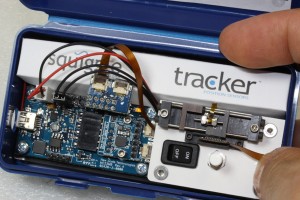Closing The Loop
by Bryan Bergeron, Editor
December 2009
If you’re a robotics enthusiast, you don’t need to be convinced of the importance of developing mechanical skills, including a hands-on familiarity with various materials, hardware components, and assembly techniques. In robotics, fluency in basic programming and mechanical engineering principles is necessary but insufficient to design and develop anything new.
When I think of robotics, the first technology that comes to mind isn’t AI, humanoid features, speech recognition, or even personality, but positive and negative feedback. That is, a true robot is a closed loop system. I can’t think of a single instance of a robot that doesn’t rely on feedback to either track its position relative to the environment or its internal mechanical motions.
My first encounter with a robot – a tube-type autopilot in the belly of a ship – taught me that feedback needn’t be complex or even pretty, but it must be robust, timely,
and accurate.
I’ve had good luck with optical shaft encoders. This closed loop technology is inexpensive, mature, and the resolution is virtually unlimited. If your digital counter chip can handle the data stream, there’s an encoder out there that will provide you with whatever resolution you need. For wheeled vehicles, a combination of an optical shaft encoder with PID feedback and GPS seems to be the magic combination. With the encoder data, the microcontroller/microprocessor can determine how to best maintain a specific velocity, while the GPS data is used to validate the vehicle’s movement in the environment.
The situation is less certain in the fields of miniature and micro-miniature robotics. Shaft encoders aren’t as useful, in part because of the sheer bulk of the LEDs and photodiodes needed to read the encoder wheels. Linear encoders suffer the same limitations. Miniaturization of motors has progressed at a more rapid pace than encoders and other means of closing the loop.
About a year ago, I had the opportunity to review the Squiggle micro-motor from New Scale Technology ([url=http://www.newscaletech.com]http://www.newscaletech.com[/url]). I tried to imagine a dozen little squiggling quartz motors propelling a dime-sized crawler along a desktop or even a wall. At the time, there were two glaring items missing from the technology mix: a lightweight battery and a practical means of closing the loop. While battery technology hasn’t evolved much in the past year, there have been advances in miniature sensor technology.
A notable advance is the Tracker position sensor from the makers of the Squiggle. I had a chance to evaluate the rather expensive Developer’s kit, shown in the accompanying photo. The complete kit (including batteries) comes in a plastic box the size of an Altoid tin. There’s a Squiggle motor, controller electronics, and the new Tracker sensor in the box. In the photo, I’m pressing the ‘forward’ button, instructing the motor to push its plunger to the right.
The Tracker is a chip-based magnetic sensor that can easily sit within the confines of a dime. The chip features digital encoding to offload the computational burden from the main processor. Resolution is a respectable 0.5 um, thanks in part to a linear array of eight Hall-effect sensors. The Squiggle is surprisingly fast.
The catch – there’s always a catch – is the bulk and mass of the peripheral components. For example, the ribbon cable connecting the sensor to the microcontroller is half as wide as the chip. If you examine the figure closely, you can see the magnetic strip that contains alternating North-South poles is about 1/5th the size of the sensor chip. The demo kit also requires a couple AAA batteries for operation.
So, although my vision of an insect-like crawler made of Squiggle motors will have to wait another year or more for battery technology to catch up, at least there’s a closed loop solution for what’s advertised as the world’s smallest motor.
Assuming DARPA’s research into Hybrid Insect Micro-Electro-Mechanical Systems (HI-MEMS) is on schedule, the ultimate in miniature closed loop systems is likely to include organic components, as well as electronics. Insects toting cameras and microphones for military surveillance won’t be very effective without some means of directing them toward a specific target.
Perhaps we’ll learn something from these hybrid insects – after all, some of the simplest forms of life employ closed loop systems. SV

Posted by Michael Kaudze on 10/22 at 09:57 AM
